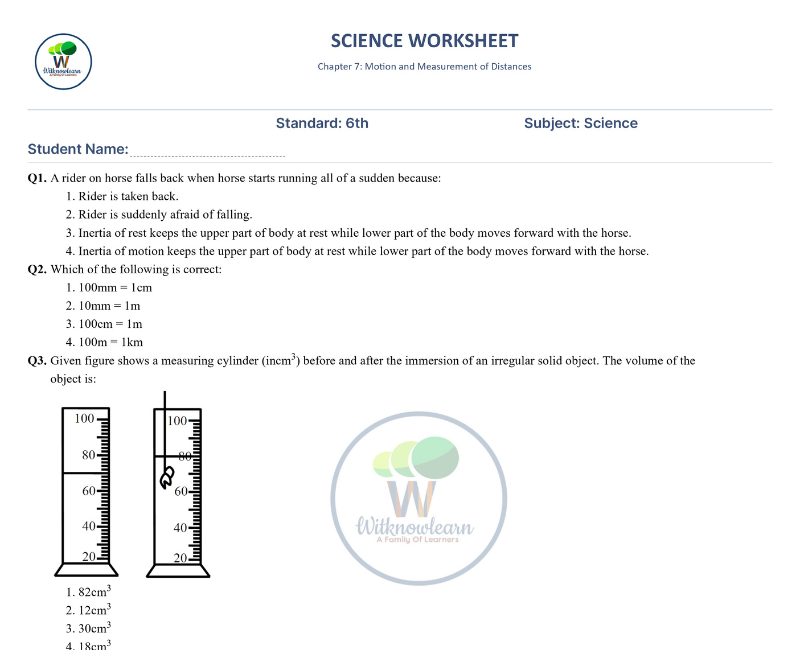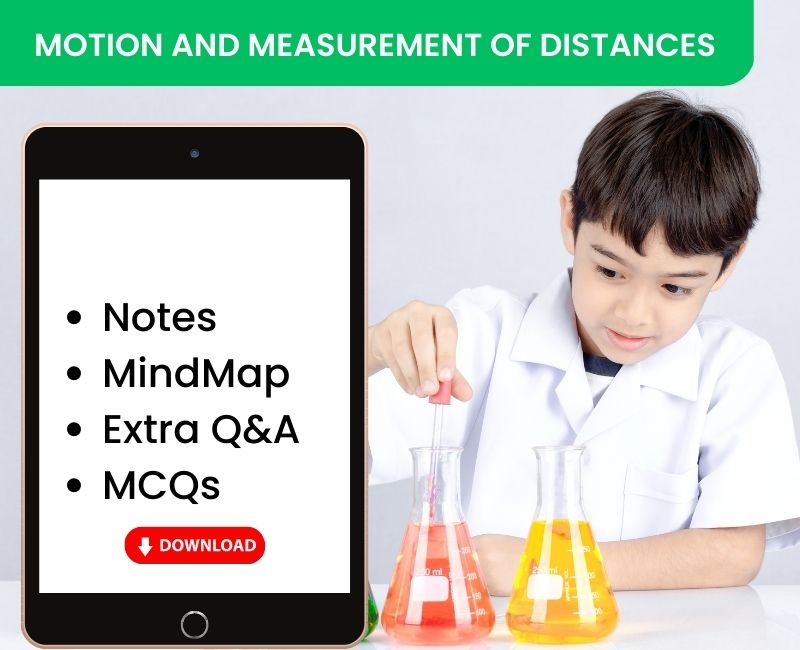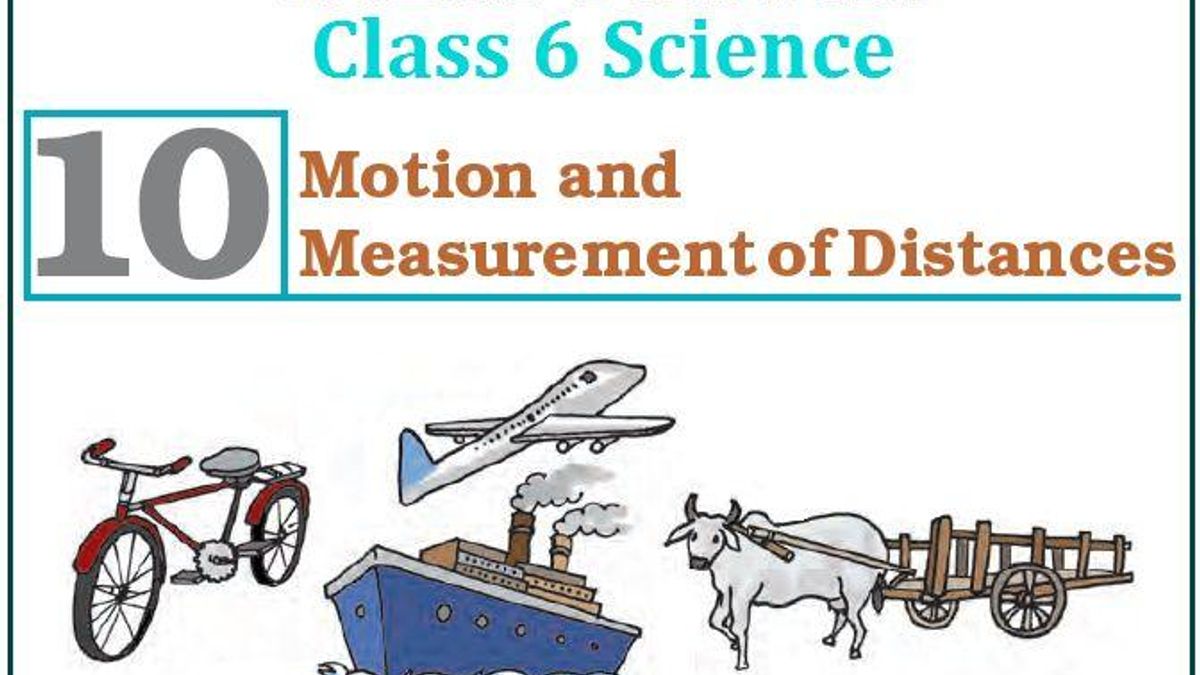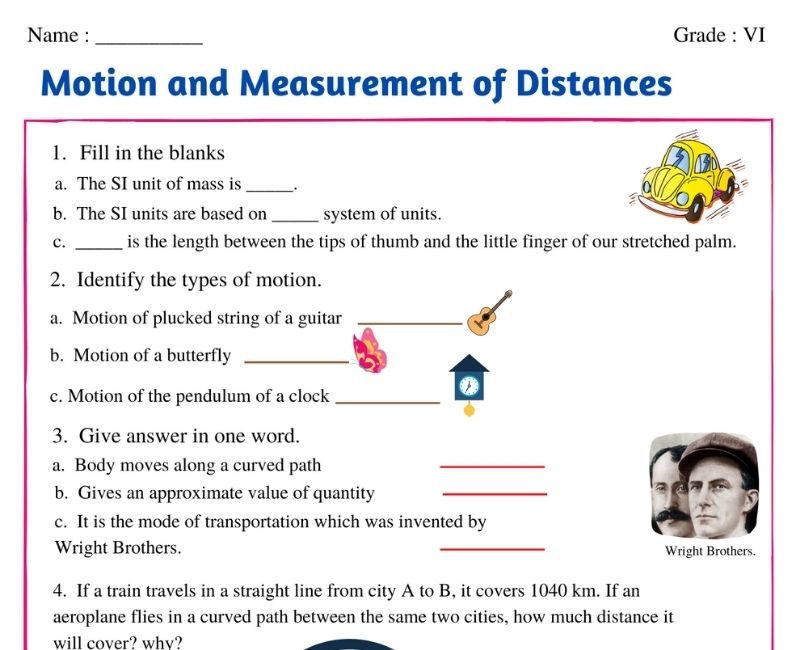
Motion and Measurement of distances NCERT Solutions Science, Solutions, Class
1. Give two examples each of modes of transport used on land, water and air. 2. Why can a pace or a foots tep not be used as a standard unit of length? 3. Arrange the following lengths in their increasing magnitude: 1 metre, 1 centimetre, 1 kilometre, 1 millimetre 4. The height of a person is 1.65 m. Express it into cm and mm. 5.

Printable Motion And Measurement of Distances class 6 Worksheet with Answer
Non-periodic motion When a body changes its position without concerning the fixed interval of time then it is called non-periodic motion. For example, the movement of clouds in the sky, a bicycle moving in a straight line and driving a car. Also Read. Notes. Motion and Measurement of distances Class 6 Notes; Assignments & NCERT Solutions

NCERT Solution for Class 6 Science Chapter 10 NcertGuru
The symbol of metre is m. Each metre (m) is divided into 100 equal divisions, called centimetre (cm). Each centimetre has ten equal divisions, called millimetre (mm). Thus. 1 m = 100 cm. 1 cm = 10 mm. For measuring large distances, metre is not a convenient unit. We define a larger unit of length.

Motion and Measurement of Distances Class 6 Notes, MCQs & More
Printable Motion and Measurement of Distances Worksheets for Class 6 Looking for an engaging way to teach your Class 6 students about motion and distance? Let them explore, experiment, and learn with these free printable worksheets! Download now to get started. Mastering Motion and Measurement of Distances - A Class 6 Guide

MCQ Questions for Class 6 Science Chapter 10 Motion and Measurement of Distances with Answers
The Worksheet and Solutions for Class 6 Science Chapter 10 contain questions and answers on various forms of transportation used to get from one place to another, motion in a straight line, measurement, rectilinear motion, SI units of measurement, the idea of metre, and so on.

Periodic Motion Examples For Kids
Class 6. English - Grammar. English - Literature. Mathematics. Mathematics (RD Sharma Soln.). Chapter 10 - Motion and Measurement of Distances - 1; Motion and Measurement Worksheet 1; Motion and Measurement Worksheet 1. Download to practice offline. 158.8 KB PDF document.
.jpg)
Motion And Measurement Of Distances NCERT Book of Class 6 Science
Answer: A quantity adopted as a standard of measurement of a physical quantity is called unit. Question 3. Name the two parts which must be mentioned to state the results of a measurement. Answer: Magnitude and unit are the two parts which must be mentioned to state the results of a measurement. Question 4.

Motion and Measurement of Distances Complete Chapter Mindmap with Explanation Class 6
Distance is the length between any two points. The process of measuring the distance is called the measurement of distances. Meter is the standard unit of measuring length. Centimeters, millimeters, and kilometers are also preferred to measure distances, depending on the magnitude of distances measured. The millimeter is the unit to measure.
.jpg)
Motion And Measurement Of Distances NCERT Book of Class 6 Science
The Worksheet Solutions: Motion & Measurement of Distances is an invaluable resource that delves deep into the core of the Class 6 exam. These study notes are curated by experts and cover all the essential topics and concepts, making your preparation more efficient and effective.
.jpg)
Motion And Measurement Of Distances NCERT Book of Class 6 Science
Worksheet for Class 6 Science Chapter 10 Motion and Measurement of Distances. Class 6 Science students should refer to the following printable worksheet in Pdf for Chapter 10 Motion and Measurement of Distances in Class 6. This test paper with questions and answers for Class 6 will be very useful for exams and help you to score good marks.

Motion And Measurement Of Distances Questions And Answers, Science For Class 6th (NCERT
Worksheet for Class 6 Science Chapter 10 Motion and Measurement of Distances. Class 6 Science students should refer to the following printable worksheet in Pdf for Chapter 10 Motion and Measurement of Distances in Class 6. This test paper with questions and answers for Class 6 will be very useful for exams and help you to score good marks.

NCERT Exemplar Solutions for Class 6 Science Chapter 10 Motion and Measurement of Distances
1. Give two examples each of modes of transport used on land, water and air. Ans: (i) Land—Bus, truck, train. (ii) Water—Ship, boat. (iii) Air—Aeroplane, Helicopter. 2. Fill in the blanks: (i) One metre is___________ (ii) Five kilometre is___________ (iii) Motion of a child on a swing is_____________ .

Printable Motion and Measurement of Distances Worksheets for Class 6
Motion and Measurement of Distances Class 6 Notes - Chapter 10 An Introduction to Motion Measuring Length A History Standard Units Errors in Measurements The Basics How to Measure a Curved Line Motion and Its Types Frequently Asked Questions on CBSE Class 6 Science Notes Chapter 10 Motion and Measurement of Distances

Motion and Measurement of Distances Class 6 Motion and Measurement of Distances class 6 NCERT
Motion and Measurement of Distances Class 6 MCQs Questions with Answers Choose the correct option. Question 1. Which is the oldest means of transport? (a) Bullock cart (b) Bus (c) Car (d) None of these Answer Question 2. The invention of which of the following has made a great change in modes of transport? (a) Wheel (b) Steam engine (c) Fire

Class 6 Science Chapter 10 NCERT Motion and Measurement of Distances YouTube
The NCERT Solutions for Class 6 Science Chapter 10 has questions and answers on topics like different modes of transport used to go from one place to another, measurement, SI units of measurement, the concept of metre, motion in a straight line, rectilinear motion, circular motion and periodic motion.

39 scientific measurement worksheet answers Worksheet Information
Class 6 Science Motion and Measurement of Distances Worksheets with Answers Chapter 10 - PDF 1. Fill in the blanks: i. Measurement is the comparison of an unknown quantity with some _______ quantity. Answer: fixed ii. 1 km = _____ m. Answer: 1000 iii. Standard unit of length is ______. Answer: metre iv.